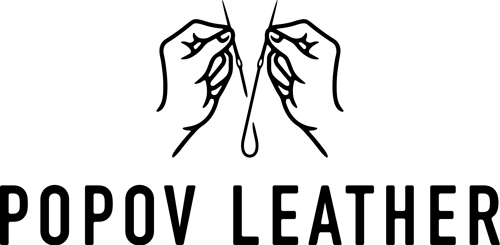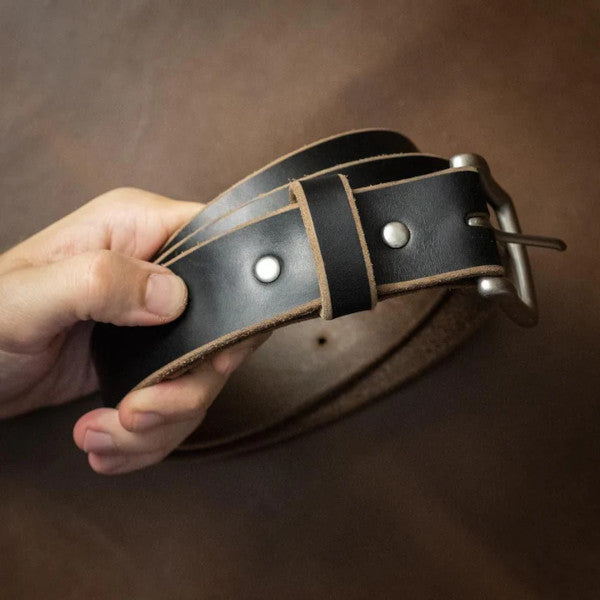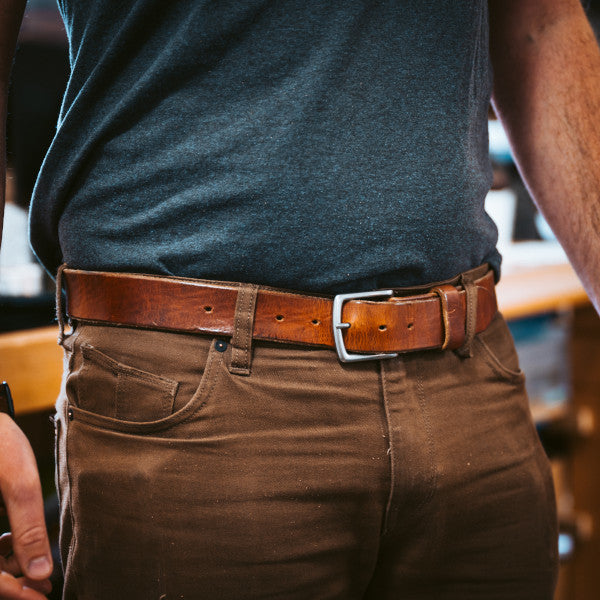A full grain leather belt stands apart not just in its appearance but also for its enduring quality.
My personal favorite is our Natural Leather Belt. It is durable, comfortable, and well worth the investment.
Full grain leather, the outermost layer of an animal hide with all its natural markings and imperfections, makes the highest quality and most exquisite belts.
Besides being premium quality, full grain leather belts:
- Provide maximum durability due to strong fibers tightly woven together
- Age beautifully, developing a rich leather patina over time
- Retain their shape, even after extensive use
- All natural leather with visible, beautiful imperfections
Table of contents
Which Belts Are Full Grain Leather?
Popov Leather's leather belts have an elegant finish and come in four colors that suit most styles—Black, English Tan, Heritage Brown, and Natural.
Below are their features and how to style them with your clothing:
|
English Tan Belt - Has an outdoorsy vibe |
Natural Belt - Pairs with every outfit |
Black Belt - Most common belt color |
Heritage Brown - Has a vintage vibe |
Fast Checklist: Is It Real Leather?
-
Label Check: Look for “100% full grain leather”
-
Natural Imperfections: Observe visible scars and irregular surface (view Patina Gallery)
-
Unique Grain Pattern: 100% unique and varied grain pattern
-
Durability: Ensure the belt feels strong
-
Tiny Holes: Check for hair follicle holes on the leather surface
- Ages Gracefully: Look for leather that develops a patina over time
Next, you can dive into the detail below for the nitty gritty on the hows, whys and more.
1 - Take Note of the Belt’s Trademark
Manufacturers often trademark their belts as real leather even if they don't make them from full grain leather. If the product label indicates “genuine leather” it’s likely low quality or synthetic.
Manufacturers who use full grain leather pride themselves in it and are quick to let you know. At Popov Leather, for instance, we make it clear in our product descriptions that all belts are made with thick, all-natural 9 oz Horween full grain leather.
This goes for any honest belt manufacturer. You’ll often see labels such as “100% full grain leather” or “genuine full grain cowhide.”
Anything different indicates another leather grade. Labels such as “genuine leather” and “top grain leather” indicate the belt uses leather but not of the highest grade.
There are also leather imitations that disguise themselves as real leather. You can quickly identify them by looking for labels such as:
- Faux leather
- Leatherette
- Synthetic leather
- Polyurethane leather
If the belt is not labeled, some additional clues will help you decide if it’s made from real full grain leather.
2 - Authentic Leather Showcases Natural Flaws
One of the easiest ways to identify a real full grain leather belt is by observing its surface. It will have a less uniform look than other grades or synthetics.
With this leather, there’s no tampering with the hide’s top layer. It’s complete, with all of its natural markings, and you’ll be able to see scars, scratches, nicks, and other so-called imperfections. It’s the topmost layer of the hide, as shown in the image below:
Tanners don't sand or perfect this leather during the tanning process so you'll notice some flaws. If someone alters the top layer, it becomes top grain, corrected grain, or genuine leather.
However, it’s worth noting that full grain leather also undergoes finishing, but in a way that doesn’t alter its grain.
Manufacturers apply either an aniline or semi-aniline finish. They treat aniline leather with a soluble dye to achieve a buttery soft and smooth texture. In contrast, they coat semi-aniline leather with a thin protective pigment to provide a consistent color and enhance its durability.
3 - Each Genuine Leather Belt Has a Unique Grain Pattern
When examining full grain leather belts, you’ll realize that no two hides are exactly the same.
Every hide is unique because it’s from a different animal with different patterns and markings. The unaltered markings (or grain patterns) of full grain leather make every belt unique.
As a result, you’ll notice that each belt has a distinct and visible grain pattern.
So if all the leather belts sold by a manufacturer have a similar grain pattern, it’s likely that they’re not made from full grain leather.
4 - A Real Full Grain Leather Belt Is Strong and Durable
The outermost layer of a hide is the strongest because its fibers are densely packed.
Since this is the layer that is used to make full grain leather belts, they’re incredibly strong and durable.
Such. belt will receive many compliments, even after years of use. If you’ve ever heard of “quarter century belts,” or those passed down from one generation to another, they’re likely made of real full grain leather.
"This is definitely a lifetime belt. You could pass this down to your grandkids."
Since the leather hasn’t been altered in any way, its entire thickness is retained. All its oil-absorbing properties and initial characteristics are left intact, increasing its durability. This is different from top grain leather, which has had its strongest fibers sanded down.
Over time, the leather develops a protective layer called patina, just as a natural hide would. The patina is long-lasting and gives the belt an attractive and unique appearance.
Expert Tip: Full grain leather belts are more susceptible to staining. To keep your belt looking new and polished after years of use, invest in an effective leather cleaner to clean and protect it from unsightly stains.

5 - Authentic Leather Features Tiny Pores
Another way to spot a real full grain leather belt is by inspecting its surface. When you look very closely, you should be able to see tiny holes in the leather. These holes are what remain once hair is removed from the skin during the tanning process.
If a leather belt’s surface lacks these small holes, it’s probably not full grain leather.
Since the skin’s pores are left intact, this leather is also more breathable than lower grades like corrected grain and split grain. This prevents the growth of mold or mildew on the belt.
Note: The older the animal used to make the leather, the more visible the pores become. While spotting the pores in both cases is still possible, it’s much easier to identify them on leather from a cow than from a calf.
The texture of this leather belt changes depending on its environment. It soaks up moisture in the atmosphere through its pores and becomes softer in a humid environment. A dry environment, on the other hand, makes it tougher.
6 - An Authentic Leather Belt Matures Gracefully Over Time
One of the key differences between a real full grain leather belt and other grades is how it ages.
Leather patina, a desirable process that develops as leather ages, is unique to full grain leather. It’s formed after the product has been subjected to continuous stretching, folding and friction.
Even after multiple scratches and blemishes, the belt will continue to look good as it absorbs the natural oils of the animal's skin, causing its surface to darken and become glossier with age.
"...The patina looks great and helps the belt pop … I plan on wearing this for years to come"
Any unique markings or scratches give a leather belt character and are a true sign of a quality product that has been used for years.
Patina will look different on every belt. It’s as unique as the belt’s owner and is highly sought after by consumers who appreciate quality leather products.

Full Grain Leather Belt: Buyers Checklist
#1: Check the Trademark/Label
- Look for labels like “100% full grain leather” or “genuine full grain cowhide”
- Avoid labels such as “genuine leather,” “top grain leather,” “faux leather,” “leatherette,” “synthetic leather,” and “polyurethane leather”
#2: Should Have Natural Imperfections
- Genuine full grain leather will have visible scars, scratches and small nicks
- Less uniform look across the entire belt, compared to inferior leather grades and synthetics
#3: Unique Grain Pattern
- Distinct, visible, irregular grain pattern over the entire belt
- No two belts should have the exact same grain pattern
#4: Strong & Durable
- Should feel solid, strong and whole to the touch, potentially lasting for decades
- Might be referred to as “quarter century belts” and are known to pass down through generations in a family
#5: Visible Presence of Tiny Holes
- Tiny holes are the remnants from where the hair follicle was removed during the tanning process
#6: Aged Appearance
- Full grain leather belts develop a patina, darkening and becoming glossier with age and regular use
- Patina will be 100% unique to each leather belt, adding character
Only Invest in Real Full Grain Leather Belts
If you want a well-made real leather belt that will last a lifetime, then Popov Leather belts are worth your investment.
All our belts are made with Horween leather that’s thick and sturdy enough to withstand constant wear. They’re everyday belts that pair well with both formal and casual outfits and develop a rich patina as they age.
Our sizing chart and video guide will help you select the correct size. As a general rule, go for a belt size that’s equal to your waist size plus two extra inches. This gives you enough room to style the belt appropriately.
Don’t hesitate to contact us for any further questions regarding our leather belts and other leather products. We’ll get back to you in a moment.
Written by Ryan Popoff
Ryan Popoff is the creative mind behind Popov Leather wallets, iPhone cases, belts, watch bands and journals since 2013. With a Bachelor Degree in Fine Arts, my leatherworking journey began at home. I wanted to create a simple leather wallet that could fit into my front pocket and — to my delight — it was a hit with family and friends. Hopefully you love our honest, quality leather goods too! Reach out with questions.




















